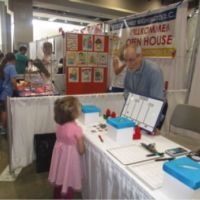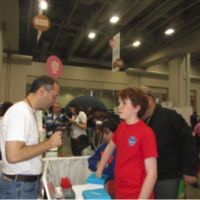
Katrina Johnson
The Science and Engineering Festival took place this past April in Washington D.C. The massive event attracted 365,000 people, and featured over 3000 hands-on activities for K-12 kids, their teachers, and their parents. Space travel, 3D printing, and water-shed management were just a few of the panoply of topics represented. SMB’s booth showcased the fusion of mathematics, computer simulation, and cellular biology. The diverse crowd of participants ranged from kindergarteners attracted to bright colors and blocks, to high school teachers seeking new ideas in relating the excitement and usefulness of math to their students. My goal in designing the exhibit was to show how math can be used to understand complex biological processes. Readers of this newsletter no doubt understand how math clarifies the mechanisms that allow cells to function, for example; however, it is easy to forget that the idea of combining math and biology is often downright puzzling to the average student. Indeed, many of our participants were attracted to the booth upon seeing the words “mathematical” and “biology” next to each other. The challenge was to pose questions motivated by biology, but mathematical in nature, and make these questions accessible to an audience with a diverse background in both biology and math. Our booth highlighted cellular signaling in an attempt to make this idea intuitive and fun for kids and adults of all ages. Participants were asked to engage in a hands-on simulation and data collection to explore how cells use molecules to communicate with other neighboring cells.
Participants drew Legos of two different colors (representing proteins) from a box (representing a cell) and tried to move information to a second cell (another box) by collecting more two-color block towers (signal complexes) than one-color block towers (inhibitory complexes). Each trial of the simulation completed by a participant posed the question will the information already received by an initial cell (a box filled with a mixture of the two different colored Lego blocks) overcome the off-setting (represented by starting the simulation with some inhibitory complexes) and allow the signal to propagate to a second and third cell. We had two simulations set up each with a different combination of blocks in the initial box and a different number of initial inhibitory complexes. The data collected allowed participants to consider how the simulation setup (combination of blocks in the first box and number of inhibitory complexes) influence the propagation of a signal to additional cells.
These hands-on simulations and the data collected illustrated how a cell might filter information received in order to strengthen the signals that propagate to additional cells. Comparison of the data from the stronger and weaker filter simulation setups demonstrated that although the stronger filter stopped more of the individual trials from proceeding to a second cell once the signal got through to the second cell information was more likely to continue on to a third cell. Younger participants enjoyed drawing out blocks and trying just one more time to get the signal to go on, while teachers commented on how such a game offers an interesting application in a course on statistics and an opportunity for students to hypothesize about the simulation setup and test these personal hypotheses by making adjustments to the setup. While completing the hands-on simulation we chatted about what types of things different cells might want to communicate and made predictions about whether the signal would actually propagate to the next cell. After completing the simulation, we recorded our data and discussed the accumulating data collected comparing the different setups.
The wealth of curiosity and wonder, especially of K-12 students, was absolutely inspiring. Interestingly, the most common reason people stopped at our booth was to ask how math and biology could possibly be studied together. Our focus was not in presenting mathematical models or solutions to biological processes, but instead to give insight using an example into the types of questions that demand mathematical modeling. Cellular signaling provided a fun way to show youth how math is used to better understand how complicated biological systems work.
For further information on The Science and Engineering Festival check out their webpage: www.usasciencefestival.org
Katrina Johnson is a graduate students in Mathematics at the University of Utah, Salt Lake City, Utah, USA. Her website is






